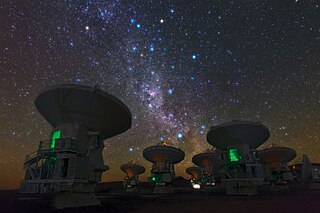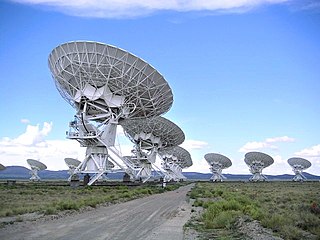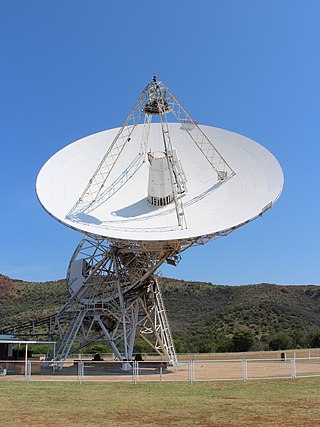
A radio telescope is a specialized antenna and radio receiver used to detect radio waves from astronomical radio sources in the sky. Radio telescopes are the main observing instrument used in radio astronomy, which studies the radio frequency portion of the electromagnetic spectrum emitted by astronomical objects, just as optical telescopes are the main observing instrument used in traditional optical astronomy which studies the light wave portion of the spectrum coming from astronomical objects. Unlike optical telescopes, radio telescopes can be used in the daytime as well as at night.

Very-long-baseline interferometry (VLBI) is a type of astronomical interferometry used in radio astronomy. In VLBI a signal from an astronomical radio source, such as a quasar, is collected at multiple radio telescopes on Earth or in space. The distance between the radio telescopes is then calculated using the time difference between the arrivals of the radio signal at different telescopes. This allows observations of an object that are made simultaneously by many radio telescopes to be combined, emulating a telescope with a size equal to the maximum separation between the telescopes.

The Karl G. Jansky Very Large Array (VLA) is a centimeter-wavelength radio astronomy observatory in the southwestern United States. It lies in central New Mexico on the Plains of San Agustin, between the towns of Magdalena and Datil, approximately 50 miles (80 km) west of Socorro. The VLA comprises twenty-eight 25-meter radio telescopes deployed in a Y-shaped array and all the equipment, instrumentation, and computing power to function as an interferometer. Each of the massive telescopes is mounted on double parallel railroad tracks, so the radius and density of the array can be transformed to adjust the balance between its angular resolution and its surface brightness sensitivity. Astronomers using the VLA have made key observations of black holes and protoplanetary disks around young stars, discovered magnetic filaments and traced complex gas motions at the Milky Way's center, probed the Universe's cosmological parameters, and provided new knowledge about the physical mechanisms that produce radio emission.

The Square Kilometre Array (SKA) is an intergovernmental international radio telescope project being built in Australia (low-frequency) and South Africa (mid-frequency). The combining infrastructure, the Square Kilometre Array Observatory (SKAO), and headquarters, are located at the Jodrell Bank Observatory in the United Kingdom. The SKA cores are being built in the southern hemisphere, where the view of the Milky Way galaxy is the best and radio interference at its least.

The Molonglo Observatory Synthesis Telescope (MOST) is a radio telescope operating at 843 MHz. It is operated by the School of Physics of the University of Sydney. The telescope is located in Hoskinstown, near the Molonglo River and Canberra, and was constructed by modification of the east–west arm of the former Molonglo Cross Telescope, a larger version of the Mills Cross Telescope.

South African Astronomical Observatory (SAAO) is the national centre for optical and infrared astronomy in South Africa. It was established in 1972. The observatory is run by the National Research Foundation of South Africa. The facility's function is to conduct research in astronomy and astrophysics. The primary telescopes are located in Sutherland, which is 370 kilometres (230 mi) from Observatory, Cape Town, where the headquarters is located.

ASTRON is the Netherlands Institute for Radio Astronomy. Its main office is in Dwingeloo in the Dwingelderveld National Park in the province of Drenthe. ASTRON is part of the institutes organization of the Dutch Research Council (NWO).

The Hartebeesthoek Radio Astronomy Observatory (HartRAO) is a radio astronomy observatory, located in a natural bowl of hills at Hartebeesthoek just south of the Magaliesberg mountain range, Gauteng, South Africa, about 50 km west of Johannesburg. It is a National Research Facility run by South Africa's National Research Foundation. HartRAO was the only major radio astronomy observatory in Africa until the construction of the KAT-7 test bed for the future MeerKAT array.

The Medicina Radio Observatory is an astronomical observatory located 30 km from Bologna, Italy. It is operated by the Institute for Radio Astronomy of the National Institute for Astrophysics (INAF) of the government of Italy.

The Murchison Widefield Array (MWA) is a joint project between an international consortium of organisations to construct and operate a low-frequency radio array. 'Widefield' refers to its very large field of view. Operating in the frequency range 70–300 MHz, the main scientific goals of the MWA are to detect neutral atomic Hydrogen emission from the cosmological Epoch of Reionization (EoR), to study the sun, the heliosphere, the Earth's ionosphere, and radio transient phenomena, as well as map the extragalactic radio sky. It is located at the Murchison Radio-astronomy Observatory (MRO).

The Jodrell Bank Centre for Astrophysics at the University of Manchester, is among the largest astrophysics groups in the UK. It includes the Jodrell Bank Observatory, the MERLIN/VLBI National Facility, and the Jodrell Bank Visitor Centre. The centre was formed after the merger of the Victoria University of Manchester and UMIST which brought two astronomy groups together. The Jodrell Bank site also hosts the headquarters of the SKA Observatory (SKAO) - the International Governmental Organisation (IGO) tasked with the delivery and operation of the Square Kilometre Array, created on the signing of the Rome Convention in 2019. The SKA will be the largest telescope in the world - construction is expected to start at the end of this decade.
In optical astronomy, interferometry is used to combine signals from two or more telescopes to obtain measurements with higher resolution than could be obtained with either telescopes individually. This technique is the basis for astronomical interferometer arrays, which can make measurements of very small astronomical objects if the telescopes are spread out over a wide area. If a large number of telescopes are used a picture can be produced which has resolution similar to a single telescope with the diameter of the combined spread of telescopes. These include radio telescope arrays such as VLA, VLBI, SMA, LOFAR and SKA, and more recently astronomical optical interferometer arrays such as COAST, NPOI and IOTA, resulting in the highest resolution optical images ever achieved in astronomy. The VLT Interferometer is expected to produce its first images using aperture synthesis soon, followed by other interferometers such as the CHARA array and the Magdalena Ridge Observatory Interferometer which may consist of up to 10 optical telescopes. If outrigger telescopes are built at the Keck Interferometer, it will also become capable of interferometric imaging.

MeerKAT, originally the Karoo Array Telescope, is a radio telescope consisting of 64 antennas in the Meerkat National Park, in the Northern Cape of South Africa. In 2003, South Africa submitted an expression of interest to host the Square Kilometre Array (SKA) Radio Telescope in Africa, and the locally designed and built MeerKAT was incorporated into the first phase of the SKA. MeerKAT was launched in 2018.

The Australian Square Kilometre Array Pathfinder (ASKAP) is a radio telescope array located at Murchison Radio-astronomy Observatory (MRO) in the Mid West region of Western Australia.

The Murchison Radio-astronomy Observatory (MRO) was established by CSIRO in 2009. It lies in a designated radio quiet zone located near Boolardy Station in the Murchison Shire of Western Australia, about 800 kilometres (500 mi) north of Perth on the traditional lands of the Wajarri peoples.
The Donald C. Backer Precision Array for Probing the Epoch of Reionization (PAPER) is a radio interferometer funded by the National Science Foundation to detect 21 cm hydrogen (HI) fluctuations occurring when the first galaxies ionized intergalactic gas at around 500 Million years after the Big Bang. PAPER is a focused experiment aimed toward making the first statistical detection of the 21 cm reionization signal. Given the stringent dynamic range requirements for detecting reionization in the face of foregrounds that are five orders of magnitude brighter, the PAPER project is taking a carefully staged engineering approach, optimizing each component in the array to mitigate, at the outset, any potentially debilitating problems in subsequent data calibration and analysis. This staged approach addresses the observational challenges that arise from very-wide-field, high-dynamic-range imaging over wide bandwidths in the presence of transient terrestrial interference. PAPER began as a collaboration between Don Backer of the UC Berkeley Radio Astronomy Laboratory and Richard Bradley of the National Radio Astronomy Observatory. With Backer's passing in 2010, Aaron Parsons has assumed leadership of PAPER on the side of UC Berkeley.
Bernard Lewis Fanaroff is a South African astronomer and trade unionist. He served in several positions in the South African government from 1994 to 2000 related to the Reconstruction and Development Programme, the RDP, and to Safety and Security.From 2003 to 2015 he led South Africa's bid to host the Square Kilometre Array Radio Telescope, the SKA, in Africa and the design and construction of the MeerKAT radio telescope. He is the co-developer of the Fanaroff–Riley classification, a method of classifying radio galaxies. He was the Project Director of South Africa's Square Kilometre Array bid.
The Hydrogen Intensity and Real-time Analysis eXperiment (HIRAX) is an interferometric array of 1024 6-meter (20ft) diameter radio telescopes, operating at 400-800MHz, that will be deployed at the Square Kilometer Array site in the Karoo region of South Africa. The array is designed to measure red-shifted 21-cm hydrogen line emission on large angular scales, in order to map out the baryon acoustic oscillations, and constrain models of dark energy and dark matter.
Science tourism is a travel topic grouping scientific attractions. It covers interests in visiting and exploring scientific landmarks, including museums, laboratories, observatories and universities. It also includes visits to see events of scientific interest, such as solar eclipses.














